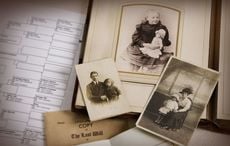Ireland’s Great Famine, which began in 1846, was marked by eviction, starvation and death. Many Irish peasants, tired of their hopeless existence, fled to America. The majority of Irish immigrants were poor, unskilled, often illiterate and predominately Roman Catholic. Their poverty and religion were considered a threat to Americans and, as is too often the case with immigrant groups, they were demonized and treated as an intellectually inferior race.
The Irish were mocked in caricatures that often dehumanized them; cartoonists such as Thomas Nast often portrayed the Irish as brutes with ape-like features. In addition, the belief that the Irish drank excessively, which often led to brawling and rioting, was widespread. In truth, a number of Irish did drink heavily, which created two powerful dynamics; it created a community among the Irish, which was good, but it provided a convenient stereotype for Nast, which wasn’t good—the brawling Irish drunk.
A number of years ago, I discovered a cartoon that was drawn by Frederick Opper, entitled "American Gold." Opper’s cartoon, which appeared in Puck Magazine, depicts a group of Irish laborers at a work site. A number of the workers, particularly the man with the pick-ax, are depicted with simian-like features, primitive and seemingly less than human. These hardworking immigrants struggled to put food on their family’s tables; yet, the workers were often pictured with disdain.
I thought of these cartoons when I found the following article in the New York Times while researching the life of one of my ancestors.
The day after this story was published, on the morning of September 21, 1868, my great-great-grandfather James Tobin, an Irish immigrant, died at the age of thirty-eight.
James was hauling bricks to the top of the building, just as one of the men in the cartoon is. It was men like my great-great-grandfather whom Nast and Opper portrayed as an inferior species.
I think about James’s life: What was his day-to-day existence like? What was his last day like? How can I breathe of his space and time?
A few weeks ago, I drove to the Lower East Side of Manhattan; I planned to trace the steps that James Tobin took on the last day of his life. I parked my car and began where his tenement would have been located, at 62 Rutgers Street. I imagined the fetid smells of poverty. The cries of the animals and the stench of death emanating from the nearby abattoirs would have filled the air of the neighborhood known as the Place of Blood.
I walked north to Canal St and turned west toward Broadway, through what is now Chinatown. I pictured the sights and sounds: people spilling out from the tenements and streets lined with pushcarts and horse-drawn wagons. I continued along the sidewalk on the north side of the street, imagining the awnings that extended from the butcher shops and groceries that lined the streets. Horse drawn wagons rumbled along Canal Street, which was made of cobblestone taking workers to and from work.
I walked three blocks to Broadway, turned right, and walked a few yards to number 424, a cast iron building, in the Soho neighborhood. I stood in the lobby. The level of fright that James must have felt as his hoist plummeted into the basement of the building is inconceivable.
I left the building and turned back toward Canal Street. I crossed Canal and continued south on Broadway to Duane Street where the New York Hospital was once located. I visualized James’ broken body being transported in a horse-drawn ambulance, with metal wheels, pounding over grimy cobblestone streets. I imagined the sounds; the pain, however, is unimaginable. And I thought of the shock that my great-great-grandmother, Grace, felt upon hearing the news that she was now a widow, and her two-year-old son, Rickard, fatherless.
I wonder what my great-great-grandmother Grace thought of cartoonists who portrayed those like her husband, my great-great-grandfather James, as an intellectually inferior species, something less than human? I can only imagine.
I am, however, strengthened by my ancestors’ tolerance and moved by their suffering. My ancestors arrived in New York City during the mid-nineteenth century. Like many, I’ve spent years trying to uncover my family history in order to understand the nineteenth-century Irish immigrant experience and its impact on who I am. The personal stories of many famine immigrants, like mine, are lost; it’s now left to those like me, the descendants, to piece together shards of memory into a coherent and useful tale.
*Originally published in 2014
---
Charles R. Hale was born, raised and educated in New York. He is a former partner of an NYC-based consulting firm Hale, Borenstein Ltd. Charles, along with Niamh Hyland, is a cofounder of Artists Without Walls, an organization purposed to inspire, uplift and unite people and communities of diverse cultures through the pursuit of artistic achievement. His film “Walls: We Are Not Forgotten,” about the life of singer Judy Collins, was presented at the 2012 Eugene O’Neill Award ceremony honoring Ms. Collins. In 2013 the City University of New York honored Charles for ”Outstanding Service to New York and Irish America.”




Comments